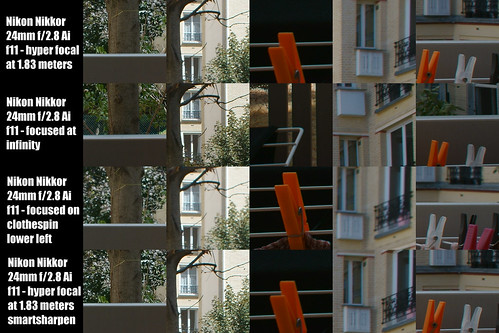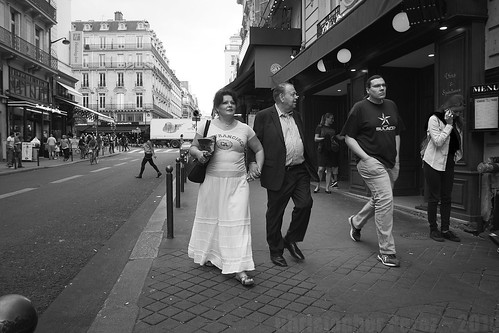Recently a friend explained to me that he was having trouble focusing a Zeiss 25mm manual focus lens on his Nikon DSLRs. Since very wide angle lenses give deep depths of field I suggested to him that he set the lens at it's hyperfocal distance, stop the lens down to f/11 and "call it good to go."
He wasn't familiar with the term "hyperfocal." So I whipped out my favorite depth of field calculator and suggested he put the focus at 6 feet 6 inches, set the aperture to f/11 and that everything from 2 feet to infinity would be in focus. I asked him to let me know what he thought after he tried it out.
Well, needless to say, he was thrilled and he sent me a couple sample images.
Which gave rise to the question of how this might look in practice. So I took out a Nikon Nikkor 24mm f/2.8 Ai, setup up a tripod, and photographed a scene with different subjects at different distances to show how it works.
Here is the base scene -

And here is a look at the results for the lens focused at the hyperfocal distance, where it is focused at infinity, where it is focused on the foreground, and a look at what happens when a smart sharpen is applied to the hyperfocal image.

What I see is that setting a lens to it's hyperfocal distance does indeed work. Everything from the orange clothespin in the foreground to the windows at infinity are "acceptably" in focus. It's a matter of how much of an "airy disk" we can accept before saying something is "out of focus." Frankly, the detail at infinity isn't all that bad.
Of course, if I took the time to focus on infinity, subjects at that distance were slightly more in focus and the foreground dropped resolution. When I focused on the foreground the clothespins were slightly better focused and the background dropped resolution. From the above image you can see for yourselves by how much resolution changes in the various scenarios.
Taking the hyperfocal image and applying a light smart sharpen was rather interesting. Of course sharpening an image does not add resolution. It adds contrast to the dark/light transition zones of an image. That is to say, it adds "apparent" resolution because the human eye sees increased contrast as increased resolution (up to a point).
Walking out into the "real world", here are a couple examples how how setting the Nikkor 24mm at f/11 and the focus at the hyperfocal distance looks in practice.


He wasn't familiar with the term "hyperfocal." So I whipped out my favorite depth of field calculator and suggested he put the focus at 6 feet 6 inches, set the aperture to f/11 and that everything from 2 feet to infinity would be in focus. I asked him to let me know what he thought after he tried it out.
Well, needless to say, he was thrilled and he sent me a couple sample images.
Which gave rise to the question of how this might look in practice. So I took out a Nikon Nikkor 24mm f/2.8 Ai, setup up a tripod, and photographed a scene with different subjects at different distances to show how it works.
Here is the base scene -

And here is a look at the results for the lens focused at the hyperfocal distance, where it is focused at infinity, where it is focused on the foreground, and a look at what happens when a smart sharpen is applied to the hyperfocal image.

What I see is that setting a lens to it's hyperfocal distance does indeed work. Everything from the orange clothespin in the foreground to the windows at infinity are "acceptably" in focus. It's a matter of how much of an "airy disk" we can accept before saying something is "out of focus." Frankly, the detail at infinity isn't all that bad.
Of course, if I took the time to focus on infinity, subjects at that distance were slightly more in focus and the foreground dropped resolution. When I focused on the foreground the clothespins were slightly better focused and the background dropped resolution. From the above image you can see for yourselves by how much resolution changes in the various scenarios.
Taking the hyperfocal image and applying a light smart sharpen was rather interesting. Of course sharpening an image does not add resolution. It adds contrast to the dark/light transition zones of an image. That is to say, it adds "apparent" resolution because the human eye sees increased contrast as increased resolution (up to a point).
Walking out into the "real world", here are a couple examples how how setting the Nikkor 24mm at f/11 and the focus at the hyperfocal distance looks in practice.


No comments:
Post a Comment